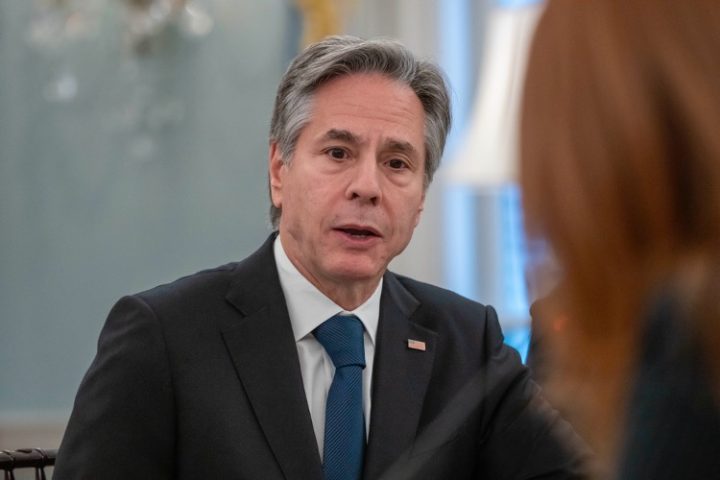
On December 27, U.S. Secretary of State Antony Blinken said that his country will offer Ukraine an additional $250 million in military aid.
The aid is part of “previously directed drawdowns for Ukraine,” Blinken said, elaborating that the package entails air-defense munitions, rockets, 155mm and 105mm artillery shells, and “over 15 million rounds” of small-arms ammunition.
Earlier this month, National Security Council spokesman John Kirby cautioned that the United States “will have no more replenishment authority available” unless Congress approves new Ukraine aid as soon as possible.
“It is imperative that Congress act swiftly, as soon as possible, to advance our national security interests by helping Ukraine defend itself and secure its future,” Blinken said. A similar statement came from the Pentagon, requesting Congress to take action “as soon as possible … to ensure that our support for Ukraine can continue.”
Lawmakers have already left Washington for the Christmas holidays, after having been unsuccessful in authorizing $60 billion in Ukraine aid requested by President Joe Biden in October. Republicans in the House of Representatives blocked the omnibus bill, demanding stricter immigration control at the U.S.-Mexico border.
The Ukrainian military is bracing for 2024 as its much-anticipated summer counteroffensive failed to make any significant military gains. Kyiv’s troops incurred heavy casualties and lost much of their valuable Western-supplied tanks and other equipment while trying to overcome thick Russian minefields and fortified positions.
On their end, the Russian forces seem to have gone on the offensive, most recently expelling Ukrainian troops from Maryinka, a major stronghold to the west of Donetsk.
Thus far, Russia’s military has apparently refrained from launching a concentrated campaign targeting Ukraine’s critical infrastructure, seemingly focusing its long-range attacks on rear facilities such as ammo dumps, airfields, and anti-aircraft defenses.
However, various officials have articulated concerns that Moscow may decide to start a new campaign against Ukraine’s critical infrastructure similar to the one it conducted during the prior winter season.
Ukrainian officials have given conflicting accounts of the degree of damage to infrastructure and of progress in fixing it. Nearly 60 percent of the country’s power generation and some 43 percent of the entire high-voltage network was damaged last year, based on statements by state-owned operator Ukrenergo. Ukrainian Prime Minister Denis Shmygal said 40 percent of the “electricity infrastructure, including generation and power grid,” was damaged, with “most of this damage” fixed.
The EU, another of Kyiv’s major backers, found itself in a deadlock over its Ukraine aid package. The long-debated tranche of €50 billion (some $55 billion) eventually was vetoed by Hungary in mid-December, with its next chance for approval delayed until next year.
Previously, Maksim Skripchenko, the president of the Transatlantic Dialogue Center, a Kyiv-based think tank, admitted that should no foreign aid arrive, it will be a “disaster” for Ukraine, Skripchenko voiced hopes that donors would eventually authorize aid for his country, though he warned that “with every week, the chances of this happening are decreasing.”
“In a month or two, we will not be able to defend ourselves against Russian missiles. We will not be able to conduct huge military operations. More than one month is a real problem,” Skripchenko told The Hill.
Faltering Western aid might make Ukraine struggle in sustaining its war efforts against Russia and also lead to the ultimate downfall of the country’s whole economy. Although Ukraine is likely able to withstand the next few months, insufficient funding would undermine Kyiv’s ability to address its 43-billion budget deficit.
“The government has a liquidity reserve for January and February,” said Yury Gayday, a senior economist with the Centre for Economic Strategy, a Kyiv think tank, told Reuters recently.
Besides tackling the budget gap, Kyiv also needs to explore ways to restructure about $20 billion in international debt after foreign bondholders agreed in mid-2022 to freeze due payments for two years. Nevertheless, Finance Minister Sergey Marchenko has said the country “hoped” to secure foreign funding, though he acknowledged that “the scenario will include the need to adapt to new conditions” should the conflict continue to drag on.
The most hawkish backers of Ukraine, however, continue to maintain that aid to the country must continue, cautioning that Ukraine’s potential defeat would be a loss for the collective West. NATO Secretary-General Jens Stoltenberg, for instance, has repeatedly said such an outcome would be “a defeat for us all.”
A similar opinion has been articulated by the former chairman of the NATO Military Committee and incumbent president of the Czech Republic, Petr Pavel, who contended that anything but a complete defeat of Russia would be a failure for the U.S.-led bloc. However, the situation whereby Ukraine could gain a military advantage over Russia was unlikely, he conceded.
“Time now favors Russia, which has a stronger base to mobilize human resources,” Pavel said in November. “Any success for Russia will mean our failure.”
Kyiv has continued its increasingly violent and lawless conscription drive since the early days of its conflict with Russia, with attempts apparently escalating in recent months to make up for heavy battlefield casualties. At the moment, it is hoping to deploy an additional 500,000 people, with the top officials reportedly trying to shift responsibility for the country’s enlarged recruitment efforts.
Ukrainian authoritarian leader Volodymyr Zelensky has claimed the figure of 500,000 conscripts was proposed by the country’s military. However, Ukraine’s top general, Valery Zaluzhny, contested Zelensky’s claim, stating that command has not actually requested any exact numbers but a steady flow of recruits to tackle its manpower shortages.
Furthermore, the secretary of Ukraine’s parliamentary national security committee, Roman Kostenko, admitted that the Ukrainian military needs 500,000 new conscripts to cover casualties and man newly established units for the next 12 months. The lawmaker also warned that eligible Ukrainians would not flee the country’s ongoing mobilization.
In an interview with the Ukrinform media outlet published on December 25, Kostenko bemoaned that his compatriots “thought that we would win soon,” which inculcated the belief in Ukrainians that “they could live quietly [and] not prepare for mobilization.”
“And now the words about an additional 450,000-500,000 mobilized have become a cold shower for everyone,” the lawmaker said. He elaborated that the figure roughly mirrors the armed forces’ needs in terms of replenishing “sanitary losses during the year” as well as creating new units. The military, according to Kostenko, must plan years ahead as the conflict “can … drag on for a long time.”



